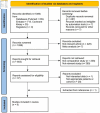Comparison of Outcomes Between Partial and Radical Laparoscopic Nephrectomy for Localized Renal Tumors Larger Than Four Centimeters: A Systematic Review and Meta-Analysis
- PMID: 38993256
- PMCID: PMC11236382
- DOI: 10.14740/wjon1866
Comparison of Outcomes Between Partial and Radical Laparoscopic Nephrectomy for Localized Renal Tumors Larger Than Four Centimeters: A Systematic Review and Meta-Analysis
Abstract
Background: Earlier studies have juxtaposed different laparoscopic methods for treating renal tumors; however, extensive evidence with a particular focus on large kidney tumors remains lacking. The objective of this meta-analysis was to assess the perioperative outcomes, kidney performance, and cancer-related results of laparoscopic partial nephrectomy (LPN) versus laparoscopic radical nephrectomy (LRN) for treating extensive, localized, non-metastatic kidney tumors (cT1b-cT2N0M0).
Methods: We systematically searched multiple databases from database inception until December 2023 for relevant studies. Selected data were analyzed with the Cochrane Collaboration's Review Manager 5.4 software using a random-effects model. Outcomes were expressed as odds ratios and weighted mean differences with 95% confidence intervals, considering a P value of < 0.05 as significant.
Results: Data from nine studies encompassing 1,303 patients (529 LPN, 774 LRN) revealed that LPN was associated with lengthier surgeries and increased blood loss compared to LRN. While LPN exhibited higher postoperative complication rates, the disparity did not reach statistical significance. LPN led to improved postoperative renal function, manifesting as a reduced estimated glomerular filtration rate (eGFR) decline and fewer incidents of new chronic kidney disease cases. Both groups demonstrated comparable tumor recurrence and overall mortality rates, but LPN exhibited significantly lower cancer-specific mortality rates.
Conclusions: LPN, despite longer operative times and greater intraoperative blood loss, was found to be superior to LRN in preserving postoperative renal function. Oncologically, LPN and LRN have comparable overall mortality rates, but LPN showed a significant advantage in terms of lower cancer-specific mortality rates.
Keywords: Kidney neoplasms; Laparoscopy; Meta-analysis; Nephrectomy; Systematic review.
Copyright 2024, Dong et al.
Conflict of interest statement
All authors have no conflict of interest to disclose.
Figures





Similar articles
-
Comparison of Partial and Radical Laparascopic Nephrectomy: Perioperative and Oncologic Outcomes for Clinical T2 Renal Cell Carcinoma.J Endourol. 2018 Oct;32(10):950-954. doi: 10.1089/end.2018.0199. Epub 2018 Sep 5. J Endourol. 2018. PMID: 30039718
-
Retroperitoneal Laparoscopic Partial Nephrectomy Versus Radical Nephrectomy for Clinical T1 Renal Hilar Tumor: Comparison of Perioperative Characteristics and Short-Term Functional and Oncologic Outcomes.J Laparoendosc Adv Surg Tech A. 2018 Oct;28(10):1183-1187. doi: 10.1089/lap.2018.0064. Epub 2018 Apr 18. J Laparoendosc Adv Surg Tech A. 2018. PMID: 29668402
-
Laparoscopic radical versus laparoscopic partial nephrectomy for clinical T1bN0M0 renal tumors: comparison of perioperative, pathological, and functional outcomes.J Endourol. 2010 Oct;24(10):1603-7. doi: 10.1089/end.2009.0312. J Endourol. 2010. PMID: 20932215
-
Perioperative, functional, and oncological outcomes of robotic vs. laparoscopic partial nephrectomy for complex renal tumors (RENAL score ≥7): an evidence-based analysis.Front Oncol. 2023 Jun 2;13:1195910. doi: 10.3389/fonc.2023.1195910. eCollection 2023. Front Oncol. 2023. PMID: 37664014 Free PMC article. Review.
-
Three-Dimensional Printing Assisted Laparoscopic Partial Nephrectomy vs. Conventional Nephrectomy in Patients With Complex Renal Tumor: A Systematic Review and Meta-Analysis.Front Oncol. 2020 Oct 22;10:551985. doi: 10.3389/fonc.2020.551985. eCollection 2020. Front Oncol. 2020. PMID: 33194610 Free PMC article.
References
LinkOut - more resources
Full Text Sources
Research Materials
Miscellaneous
